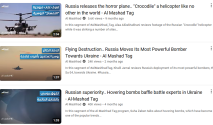What about Korea?Korea?
The initial phase of the war (in 2001), was a straight up conventional force on force war. After the US defeated the Taliban standing armed forces overwhelmingly, it then became an insurgency when the rest of the Taliban went into hiding and started striking at the US with (mostly) guerilla-style tactics, interspersed with rare force on force engagements, which it overwhelmingly lost; a very similar situation to Vietnam.OK, so you say that insurgents fight like in Afghanistan, right? Just so we are clear, the Taliban had no air force, no tanks, no artillery. They fought as light infantry teams that blended into the terrain. This is an insurgency. Do you agree?
Please answer for me, very simply: what was the total air-to-air kill ratio in Vietnam, and why in light of that would I even give one flying frack how many aces from which side are listed on a table? Here, let me help you:I must be mistaken. I am unaware of insurgents flying Mig-21s with more fighter aces and shooting down enemy planes with 2:1 kill ratios? Were the Taliban flying Migs and shooting down planes with SAMs? Please answer, what insurgency is equipped with fighters, SAMs, tanks, etc?
What was the air to air kill ratio in Afghanistan, against an insurgency? What was the air to air kill ratio in Vietnam, supposedly an 'insurgency'?
Please answer for me, very simply: do you see more names affiliated with "North Vietnam" or do you see more names affiliated with "United States" on the list of air to air fighter aces?
I'm also curious, why would the US be scared of invading North Vietnam directly? Surely that would be a conventional war and they'd win a conventional war so why did they choose to allow 'insurgents' to shoot down 10k planes?
The Air Force had a Vietnam War total of 137 kills.
Air Force planes of all types on air-to-air missions had an overall 3.8-1 kill ratio for the entire war. In an apples-to-apples comparison with the F-86s in Korea, the Air Forces’ MiGCAP F-4s in Vietnam had 5.5-1 kill ratio, with a very strong upward trend toward 15-1 during the the final five months of the war, greatly exceeding the Korean War results of 10-1.
The Navy’s kill ratios—involving a much smaller number of engagements—were 4.7-1 for aircraft of all types during the entire war, 6.4-1 for MiGCAP missions during the entire war and 8.7-1 for MiGCAPs in the Topgun era.
Freed up by Teaball to be more aggressive without fear of ambush, the MiGCAP force did spectacularly well, shooting down 15 and losing only one. In short, when the Air Force was afforded conditions similar to those that helped the Navy, the results of the two services were very similar.
The problem for your argument is again that the North Vietnamese employed both conventional and unconventional (guerilla warfare) tactics against the US military. This is in the same vein of warfare used by the Taliban. The US overwhelmingly tends to win straight up force-on-force engagements, while suffering a death by a thousand cuts on the receiving end of an insurgency-style war.
You said the offensive on Kiev was a feint for the purpose of "deflecting" from their (true) eastern offensive. Have you changed your mind, then?I don’t think all of that was just hindsight. Instead, I believe the Russians initially underestimated the sheer level of resistance they would face from Ukrainians, along with the deep-seated hostility toward their rule. This miscalculation is why the offensive on Kyiv failed.
On this we could agree.At the same time, they also underestimated their own ability to sustain the war economy and withstand Western sanctions. Likewise, they overestimated the West’s financial capacity to wage economic warfare and its industrial strength to sustain a prolonged conflict.
Putin certainly has come to see that Western sanctions have limited value, and that Russia's economy is more resilient than the West, or perhaps even Putin, believed initially. But this is certainly to have been a conclusion come to by hindsight, not as you say, as a strategy set from the beginning to bleed Europe.At some point, I think Putin recognized the long-term advantages of engaging in protracted warfare in Eastern Ukraine (the ones I mentioned in the last post), which is why they avoided overcommitting there and went slowly.
So, even if Trump hadn’t come into office in 2024, I believe Russia would have still preferred this strategy moving forward; And what about the 2028 elections? What about Taiwan? What about the West’s continued decline?
In the end, Putin and Russia have gained significant leverage, which is why Trump is making so many concessions in these talks.

